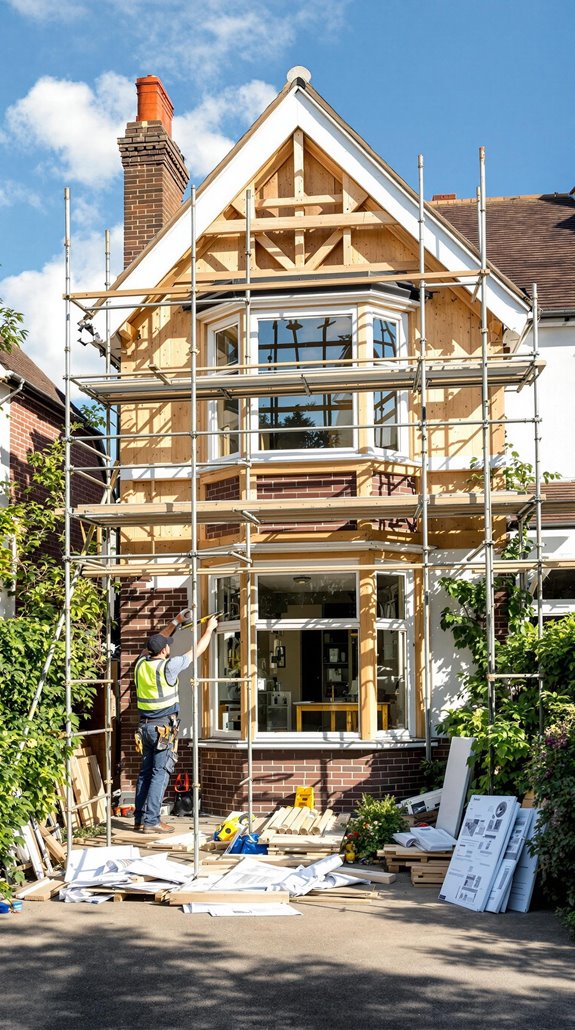I’ll walk you through the essential aspects of Permitted Development Rights that can transform your property development approach in the UK. Whether you’re planning a home extension, considering a commercial conversion, or exploring ways to add value without the traditional planning permission headaches, understanding these rights isn’t just helpful—it’s critical. However, there’s a maze of regulations, restrictions, and compliance requirements that can either make or break your project before it even begins.
Key Takeaways
- PDRs allow property modifications without full planning permission under the Town and Country Planning (General Permitted Development) Order 2015.
- Householder rights permit single-storey extensions up to 3-4m depth and two-storey extensions with 10m boundary clearance requirements.
- Commercial to residential conversions no longer have floor space caps, requiring only two years of previous commercial use.
- Prior approval applications take eight weeks to process, with automatic approval if no LPA response is received.
- Common mistakes include unauthorized works, material changes during implementation, and failure to maintain detailed compliance records.
What Are Permitted Development Rights and How Do They Work
Permitted development rights function as legal shortcuts that let you modify your property without traversing the full planning permission process. I’ll explain how these rights work to help you navigate property improvements efficiently.
These rights stem from the Town and Country Planning (General Permitted Development) Order 2015, which automatically grants permission for specific developments that meet predetermined criteria. You’re fundamentally getting pre-approved permission for common property modifications like extensions, outbuildings, and minor alterations.
The system operates on a “tick-box” approach—if your project fits within the defined parameters, you can proceed without lengthy planning applications. However, you’ll still need “prior approval” from your Local Planning Authority for certain developments, though they’ll only assess limited technical criteria rather than subjective design elements. These rights have been established to simplify the planning process since 1948, creating a more streamlined approach for property owners.
Key Benefits of Using PDRs for Property Development
When you leverage permitted development rights, you’ll access substantial advantages that transform how you approach property development. I’ve seen how PDRs eliminate full planning applications, cutting administrative costs and accelerating your project timelines considerably. You’ll avoid lengthy council consultations while reducing professional fees through simplified procedures.
Your property value increases through extensions, conversions, and modernization opportunities. You can profitably convert commercial spaces to residential units, add sellable square footage, and modernize underutilized buildings into high-demand housing. The development flexibility is remarkable—you’re permitted upward extensions up to two storeys, change of use from commercial to residential, and basement conversions within defined parameters. Understanding leasehold agreements is also crucial, as they dictate specific restrictions that may impact your renovation plans.
PDRs provide regulatory certainty with clearly defined rules, standardized criteria, and predictable outcomes. You’ll minimize approval uncertainties while supporting urban regeneration efforts that address housing shortages and revitalize vacant commercial buildings. However, compliance with regulations is essential to avoid fines and reversal of changes that could undermine your investment returns.
Householder Rights for Extensions and Home Improvements

The most accessible application of permitted development rights occurs through householder extensions and home improvements, where you can expand your property’s footprint and functionality without full planning permission. I’ll walk you through the key opportunities available to you as a homeowner.
For single-storey extensions, you’re allowed 3m depth on attached houses and 4m on detached properties, with a 4m height limit. In general, permitted development rights can help you avoid lengthy planning processes while ensuring compliance with local regulations. Side extensions can’t exceed 50% of your original width, and materials must match existing construction.
Two-storey extensions require 10m clearance from all boundaries, with maximum height matching your existing dwelling. Roof pitch must align with the original design.
Loft conversions offer excellent expansion potential, though dormers face restrictions on front-facing elevations and must maintain 300mm clearance from roof edges. Consider obtaining a Lawful Development Certificate to provide formal proof that your extension complies with permitted development regulations.
Commercial to Residential Conversion Opportunities
Beyond householder improvements, commercial-to-residential conversions present significant opportunities for property developers and investors looking to capitalize on recent legislative changes. I’ve seen the removal of the 1,500 sqm floor space cap and mandatory three-month vacancy requirement transform project viability overnight.
You can now initiate development before tenants vacate, streamlining timelines considerably. The data speaks volumes—95,962 homes created through office-residential PDRs since 2015, with commercial property values declining 15% since 2021, enhancing investment appeal. Understanding local planning policies is crucial to navigate the complexities of this transition effectively.
However, you’ll need prior approval for natural light, transport impact, and contamination risks. Properties must demonstrate two years of previous commercial use before qualifying for conversion applications. For agricultural conversions, act before May 2025 when restrictions prohibit single large dwellings exceeding 150 sqm.
Strategic implementation requires structural assessments, bridging finance, and compliance audits to prevent disputes.
Understanding Restrictions and Limitations in Protected Areas

Although commercial conversions offer exciting opportunities, protected areas impose stringent restrictions that can derail projects without proper planning. I’ve seen countless developers stumble because they didn’t understand Article 2(3) land classifications in conservation areas, where cladding becomes prohibited and extension limits shrink dramatically. Additionally, understanding permitted development rights can help navigate these complexities more effectively.
Your permitted development rights vanish in National Parks, AONBs, and World Heritage Sites. Single-story rear extensions can’t extend beyond original rear walls, and two-story additions face complete prohibitions. Article 4 Directions remove even basic rights, though you won’t pay planning fees when these apply.
I always recommend contacting your Local Planning Authority first. Protected species surveys become mandatory, and Natural England consultation often follows. Even developments that don’t require planning permission may need ecological surveys to assess local wildlife impacts. Understanding these restrictions upfront prevents costly redesigns and protects your investment timeline.
The Prior Approval Process Explained
When your permitted development project triggers specific size thresholds or impact concerns, you’ll need prior approval from your Local Planning Authority before breaking ground. I’ll walk you through this streamlined process that focuses on specific impacts rather than broad planning considerations.
You’ll submit detailed plans and impact assessments addressing only designated concerns like transport, highways, noise, or flooding. Your LPA can’t consider design aesthetics or broader planning principles – they’re restricted to evaluating the specific triggers that apply to your project. It’s also important to be aware of potential planning permission breaches that may arise if changes are made without necessary approvals.
The determination period is eight weeks from submission. If your LPA doesn’t respond within this timeframe, you’ll receive automatic approval. Once granted, you’ve got three years to commence development, giving you flexibility to plan your project timeline effectively. It’s crucial to research your site’s planning history and any designated area restrictions before submitting your application.
Article 4 Directions and Their Impact on Development Rights
While the prior approval process streamlines many permitted development projects, your local planning authority can strip away these rights entirely through Article 4 Directions. These legal instruments target specific development rights that threaten local character or heritage, particularly in conservation areas or residential zones facing unwanted HMO conversions.
I’ve seen councils remove rights for external alterations like window replacements or changes of use from offices to residential. The key point: Article 4 Directions don’t prohibit development—they simply require full planning permission for works that would otherwise proceed under permitted development.
You’ll receive notice periods before these restrictions take effect, and councils must justify their decisions with evidence. The Secretary of State also holds the power to make Article 4 Directions alongside local planning authorities. Check your local authority’s website to identify any existing or proposed Article 4 Directions affecting your property before starting development work.
Compliance Requirements and Legal Verification
Since permitted development rights operate within strict legal parameters, maintaining compliance requires systematic verification and documentation throughout your project. I’ll guide you through essential compliance steps that protect your investment and avoid costly enforcement issues.
First, verify your property classification under the General Permitted Development Order 2015 and confirm no Article 4 Directions restrict your rights. Submit written notification to your local planning authority before commencing, providing detailed project information including scale, design, and site plans. Engaging with your planning authority early can help you avoid planning permission pitfalls that may lead to project denial.
Construct strictly according to approved specifications, maintaining detailed progress records for validation. If modifications arise, contact your council immediately for guidance on amendment protocols. Document all authority responses and retain evidence of notification submissions. Applications typically incur a small fee and processing time of up to 8 weeks. This systematic approach guarantees your development remains legally compliant throughout completion.
Common Mistakes That Invalidate PDR Eligibility

Understanding what invalidates your permitted development rights proves essential for avoiding costly legal complications and project delays. I’ve seen countless property owners lose their PDR eligibility through preventable mistakes.
Unauthorized building works immediately void your rights under Article 3(5) GPDO. Once you’ve made unlawful modifications, remedial works can’t reinstate lapsed rights—you’ll need to reapply entirely. Your rights remain suspended until unauthorized elements are fully removed or regularized.
Material changes during PD implementation terminate rights instantly. You must strictly adhere to approved plans and operational timelines. Partial implementation or unlawful intermediate uses between phases invalidate your entire development rights.
Planning conditions with vague wording like “for no other purpose” without “whatsoever” may inadequately remove PDR. I recommend ensuring conditions explicitly reference GPDO override to prevent ambiguity. The strict interpretation requirement means conditions must be unequivocal to exclude permitted development rights effectively.
Planning Your Project Within PDR Guidelines
After addressing compliance pitfalls, successful PDR implementation requires methodical project planning that aligns with current regulatory frameworks. I’ll guide you through the essential steps that guarantee your project stays within permitted boundaries.
Start by verifying your property’s eligibility under the Town and Country Planning (General Permitted Development) (England) Order 2015. Single-storey extensions, loft conversions, and garden outbuildings represent the most common PDR projects, each with specific dimensional limits you must respect. Engaging an experienced architect who can navigate the complexities of the planning system will significantly enhance your project’s chances of success.
I recommend obtaining a Lawful Development Certificate before beginning work. This pre-application process confirms your project’s compliance and protects against future enforcement action. Document all measurements carefully, particularly height restrictions and boundary setbacks. Even with permitted development rights, you must still comply with building regulations to ensure safety and structural integrity.
Consider 2025’s updated requirements including flood-risk restrictions and energy efficiency standards that now apply to renovation projects, guaranteeing your planning incorporates these mandatory elements.
Conclusion
I’ve covered the essential aspects of PDRs you’ll need to navigate UK property development successfully. Remember, while these rights offer significant advantages, you must verify your project’s compliance with local restrictions, Article 4 directions, and technical requirements before proceeding. Don’t assume eligibility—always check with your local planning authority and consider professional advice for complex projects. Proper planning within PDR guidelines protects your investment and guarantees smooth project delivery.
References
- https://rodicdavidson.co.uk/permitted-development-rights/
- https://www.designingbuildings.co.uk/wiki/Permitted development
- https://assets.publishing.service.gov.uk/media/5d77afc8e5274a27cdb2c9e9/190910_Tech_Guide_for_publishing.pdf
- https://commonslibrary.parliament.uk/research-briefings/sn00485/
- https://resi.co.uk/advice/permitted-development
- https://searchland.co.uk/blog/what-are-permitted-development-rights
- https://www.designingbuildings.co.uk/wiki/Permitted Development Rights
- https://en.wikipedia.org/wiki/General_Permitted_Development_Order
- https://www.gov.uk/government/publications/permitted-development-rights-for-householders-technical-guidance
- https://forthactioninvest.co.uk/transform-your-property-with-permitted-development/

